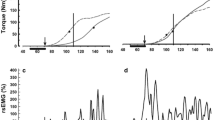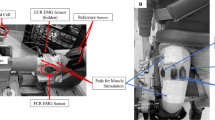Abstract
The purpose of this study is to investigate whether regional modulation of the ankle plantarflexors during standing was related to the recruitment of motor units associated with force direction. Fourteen participants performed a multi-directional leaning task in standing. Participants stood on a force platform and maintained their center of pressure in five different target directions. Motor unit firings were extracted by decomposition of high-density surface electromyograms recorded from the ankle plantarflexor muscles. The motor unit barycentre, defined as the weighted mean of the maximal average rectified values across columns and rows, was used to evaluate the medio-lateral and proximo-distal changes in the surface representation of single motor units across different leaning target directions. Using a motor unit tracking analysis, groups of motor units were identified as being common or unique across the target directions. The leaning directions had an effect on the spatial representations of motor units in the medial gastrocnemius and soleus (p < 0.05), but not in the lateral gastrocnemius (p > 0.05). Motor unit action potentials were represented in the medial and proximal aspects of the muscles during forward vs. lateral leans. Further analysis determined that the common motor units were found in similar spatial locations across the target directions, whereas newly recruited unique motor units were found in different spatial locations according to target direction (p < 0.05). The central nervous system may possess the ability to activate different groups of motor units according to task demands to meet the force-direction requirements of the leaning task.





Similar content being viewed by others
Availability of data and material
The research data are confidential.
Code availability
Not applicable.
References
Binder MD, Heckman C, Powers RK (2010) The physiological control of motoneuron activity. Compr Physiol. https://doi.org/10.1002/cphy.cp120101
Butler JE, Gandevia SC (2008) The output from human inspiratory motoneurone pools. J Physiol 586:1257–1264
Cerone GL, Botter A, Gazzoni M (2019) A modular, smart, and wearable system for high density sEMG detection. IEEE Trans Biomed Eng 66:3371–3380. https://doi.org/10.1109/TBME.2019.2904398
Chanaud CM, Pratt CA, Loeb GE (1991) Functionally complex muscles of the cat hindlimb. V. The roles of histochemical fiber-type regionalization and mechanical heterogeneity in differential muscle activation. Exp Brain Res 85:300–313. https://doi.org/10.1007/BF00229408
Cohen JW, Gallina A, Ivanova TD, Vieira T, McAndrew DJ, Garland SJ (2020) Regional modulation of the ankle plantarflexor muscles associated with standing external perturbations across different directions. Exp Brain Res 238:39–50. https://doi.org/10.1007/s00221-019-05696-8
Desnedt H, Gidaux E (1981) Spinal motoneuron recruitment in man: rank deordering with direction but not with speed of voluntary movement. Science 214:933–936
Di Giulio I, Maganaris CN, Baltzopoulos V, Loram ID (2009) The proprioceptive and agonist roles of gastrocnemius, soleus and tibialis anterior muscles in maintaining human upright posture. J Physiol 587:2399–2416. https://doi.org/10.1113/jphysiol.2009.168690
Dos Anjos F, Fontanella F, Gazzoni M, Vieira T (2015) Does the global temporal activation differ in triceps surae during standing balance? In: 2015 37th Annual international conference of the IEEE engineering in medicine and biology society (EMBC). IEEE, pp 3464–3467
Dunn OJ (1964) Multiple comparisons using rank sums. Technometrics 6:241–252
Farina D, Merletti R, Nazzaro M, Caruso I (2001) Effect of joint angle on EMG variables in leg and thigh muscles. IEEE Eng Med Biol Mag 20:62–71. https://doi.org/10.1109/51.982277
Farina D, Arendt-Nielsen L, Merletti R, Graven-Nielsen T (2002) Assessment of single motor unit conduction velocity during sustained contractions of the tibialis anterior muscle with advanced spike triggered averaging. J Neurosci Methods 115:1–12. https://doi.org/10.1016/s0165-0270(01)00510-6
Farina D, Merletti R, Enoka RM (2004) The extraction of neural strategies from the surface EMG. J Appl Physiol 96:1486–1495. https://doi.org/10.1152/japplphysiol.01070.2003
Farina D, Negro F, Gazzoni M, Enoka RM (2008) Detecting the unique representation of motor-unit action potentials in the surface electromyogram. J Neurophysiol 100:1223–1233. https://doi.org/10.1152/jn.90219.2008
Fortier PA, Kalaska JF, Smith AM (1989) Cerebellar neuronal activity related to whole-arm reaching movements in the monkey. J Neurophysiol 62:198–211
Fukunaga T, Roy RR, Shellock FG et al (1992) Physiological cross-sectional area of human leg muscles based on magnetic resonance imaging. J Orthop Res 10:928–934. https://doi.org/10.1002/jor.1100100623
Gallina A, Merletti R, Gazzoni M (2013a) Uneven spatial distribution of surface EMG: what does it mean? Eur J Appl Physiol 113:887–894. https://doi.org/10.1007/s00421-012-2498-2
Gallina A, Ritzel CH, Merletti R, Vieira TMM (2013b) Do surface electromyograms provide physiological estimates of conduction velocity from the medial gastrocnemius muscle? J Electromyogr Kinesiol 23:319–325. https://doi.org/10.1016/j.jelekin.2012.11.007
Georgopoulos AP, Schwartz AB, Kettner RE (1986) Neuronal population coding of movement direction. Science 233:1416–1419
Georgopoulos AP, Kettner RE, Schwartz AB (1988) Primate motor cortex and free arm movements to visual targets in three-dimensional space. II. Coding of the direction of movement by a neuronal population. J Neurosci 8:2928–2937
Henneman E, Somjen G, Carpenter DO (1965) Functional significance of cell size in spinal motoneurons. J Neurophysiol 28:560–580
Heroux ME, Dakin CJ, Luu BL, Inglis JT, Blouin JS (2014) Absence of lateral gastrocnemius activity and differential motor unit behavior in soleus and medial gastrocnemius during standing balance. J Appl Physiol 116:140–148. https://doi.org/10.1152/japplphysiol.00906.2013
Herrmann U, Flanders M (1998) Directional tuning of single motor units. J Neurosci 18:8402–8416
Hodson-Tole EF, Wakeling JM (2009) Motor unit recruitment for dynamic tasks: current understanding and future directions. J Compar Physiol B 179:57–66. https://doi.org/10.1007/s00360-008-0289-1
Hodson-Tole EF, Loram ID, Vieira TM (2013) Myoelectric activity along human gastrocnemius medialis: different spatial distributions of postural and electrically elicited surface potentials. J Electromyogr Kinesiol 23:43–50
Hoffer JA, Loeb GE, Sugano N, Marks WB, O’Donovan MJ, Pratt CA (1987) Cat hindlimb motoneurons during locomotion. III. Functional segregation in sartorius. J Neurophysiol 57:554–562. https://doi.org/10.1152/jn.1987.57.2.554
Holobar A, Minetto M, Botter A, Farina D (2011) Identification of motor unit discharge patterns from high-density surface EMG during high contraction levels. 5th European conference of the international federation for medical and biological engineering. Springer, Berlin, pp 1165–1168
Kadmon Harpaz N, Ungarish D, Hatsopoulos NG, Flash T (2019) Movement decomposition in the primary motor cortex. Cereb Cortex 29:1619–1633
Kalaska J, Caminiti R, Georgopoulos A (1983) Cortical mechanisms related to the direction of two-dimensional arm movements: relations in parietal area 5 and comparison with motor cortex. Exp Brain Res 51:247–260
Kernell D (2003) Principles of force gradation in skeletal muscles. Neural Plast 10:69–76. https://doi.org/10.1155/NP.2003.69
Kinugasa R, Kawakami Y, Sinha S, Fukunaga T (2011) Unique spatial distribution of in vivo human muscle activation. Exp Physiol 96:938–948. https://doi.org/10.1113/expphysiol.2011.057562
Kolasinski J, Dima DC, Mehler DM, Stephenson A, Valadan S, Kusmia S, Rossiter HE (2020) Spatially and temporally distinct encoding of muscle and kinematic information in rostral and caudal primary motor cortex. Cerebral Cortex Communications 1:tgaa009
Lee SS, Piazza SJ (2008) Inversion–eversion moment arms of gastrocnemius and tibialis anterior measured in vivo. J Biomech 41:3366–3370
Lee D, Quessy S (2003) Activity in the supplementary motor area related to learning and performance during a sequential visuomotor task. J Neurophysiol 89:1039–1056
Loeb GE (1985) Motoneurone task groups: coping with kinematic heterogeneity. J Exp Biol 115:137–146
Loram ID, Maganaris CN, Lakie M (2004) Paradoxical muscle movement in human standing. J Physiol 556:683–689
Lowery MM, Weir REF, Kuiken TA (2006) Simulation of intramuscular-EMG signals detected using implantable myoelectric sensors (IMES). IEEE Trans Biomed Eng 53:1926–1933. https://doi.org/10.1109/Tbme.2006.881774
Macpherson JM, Horak FB, Dunbar DC, Dow RS (1989) Stance dependence of automatic postural adjustments in humans. Exp Brain Res 78:557–566
Merletti R, Farina D (2009) Analysis of intramuscular electromyogram signals. Philos Trans R Soc Math Phys Eng Sci 367:357–368. https://doi.org/10.1098/rsta.2008.0235
Mesin L, Merletti R, Vieira TM (2011) Insights gained into the interpretation of surface electromyograms from the gastrocnemius muscles: a simulation study. J Biomech 44:1096–1103
Milner-Brown HS, Stein RB, Yemm R (1973) The orderly recruitment of human motor units during voluntary isometric contractions. J Physiol 230:359–370. https://doi.org/10.1113/jphysiol.1973.sp010192
Morasso PG, Sanguineti V (2002) Ankle muscle stiffness alone cannot stabilize balance during quiet standing. J Neurophysiol 88:2157–2162
Rainoldi A, Nazzaro M, Merletti R, Farina D, Caruso I, Gaudenti S (2000) Geometrical factors in surface EMG of the vastus medialis and lateralis muscles. J Electromyogr Kinesiol 10:327–336
Scherberger H, Jarvis MR, Andersen RA (2005) Cortical local field potential encodes movement intentions in the posterior parietal cortex. Neuron 46:347–354
Segal RL, Song AW (2005) Nonuniform activity of human calf muscles during an exercise task. Arch Phys Med Rehabil 86:2013–2017. https://doi.org/10.1016/j.apmr.2005.04.012
Staudenmann D, Kingma I, Daffertshofer A, Stegeman D, Van Dieën J (2009) Heterogeneity of muscle activation in relation to force direction: a multi-channel surface electromyography study on the triceps surae muscle. J Electromyogr Kinesiol 19:882–895
Thomsen MH, Stottrup N, Larsen FG, Pedersen AMSK, Poulsen AG, Hirata RP (2017) Four-way-leaning test shows larger limits of stability than a circular-leaning test. Gait Posture 51:10–13. https://doi.org/10.1016/j.gaitpost.2016.09.018
Truccolo W, Friehs GM, Donoghue JP, Hochberg LR (2008) Primary motor cortex tuning to intended movement kinematics in humans with tetraplegia. J Neurosci 28:1163–1178
Vieira TM, Botter A (2021) The accurate assessment of muscle excitation requires the detection of multiple surface electromyograms. Exerc Sport Sci Rev 49:23–34. https://doi.org/10.1249/Jes.0000000000000240
Vieira TMM, Merletti R, Mesin L (2010) Automatic segmentation of surface EMG images: Improving the estimation of neuromuscular activity. J Biomech 43:2149–2158. https://doi.org/10.1016/j.jbiomech.2010.03.049
Vieira TM, Loram ID, Muceli S, Merletti R, Farina D (2011) Postural activation of the human medial gastrocnemius muscle: are the muscle units spatially localised? J Physiol 589:431–443. https://doi.org/10.1113/jphysiol.2010.201806
Vieira TM, Loram ID, Muceli S, Merletti R, Farina D (2012) Recruitment of motor units in the medial gastrocnemius muscle during human quiet standing: is recruitment intermittent? What triggers recruitment? J Neurophysiol 107:666–676
Vieira TM, Minetto MA, Hodson-Tole EF, Botter A (2013) How much does the human medial gastrocnemius muscle contribute to ankle torques outside the sagittal plane? Hum Mov Sci 32:753–767
Vieira TM, Botter A, Muceli S, Farina D (2017) Specificity of surface EMG recordings for gastrocnemius during upright standing. Sci Rep. https://doi.org/10.1038/s41598-017-13369-1
Watanabe K, Kouzaki M, Moritani T (2013) Region-specific myoelectric manifestations of fatigue in human rectus femoris muscle. Muscle Nerve 48:226–234. https://doi.org/10.1002/mus.23739
Acknowledgements
This work was supported by the Natural Sciences and Engineering Research Council of Canada
Funding
This work was supported by the Natural Sciences and Engineering Research Council of Canada: NSERC RGPIN 105424-12.
Author information
Authors and Affiliations
Contributions
JWC: conception, data collection, analysis, interpretation of data, and writing original draft. TV: conception, analysis, interpretation of data, and writing review and editing. GLC: data collection, analysis, and writing review and editing. TDI: analysis, interpretation of data, and writing review and editing. SJG: conception, interpretation of data, writing review and editing, and supervision.
Corresponding author
Ethics declarations
Conflict of interest
The authors have no conflicts of interest to declare.
Ethical approval
This study was approved by the Research Ethics Committee of Western University, and conducted in accordance with the Declaration of Helsinki.
Consent to participate
Informed consent was obtained from all participants included in the study.
Additional information
Communicated by Bill J. Yates.
Publisher's Note
Springer Nature remains neutral with regard to jurisdictional claims in published maps and institutional affiliations.
Rights and permissions
About this article
Cite this article
Cohen, J.W., Vieira, T., Ivanova, T.D. et al. Maintenance of standing posture during multi-directional leaning demands the recruitment of task-specific motor units in the ankle plantarflexors. Exp Brain Res 239, 2569–2581 (2021). https://doi.org/10.1007/s00221-021-06154-0
Received:
Accepted:
Published:
Issue Date:
DOI: https://doi.org/10.1007/s00221-021-06154-0




